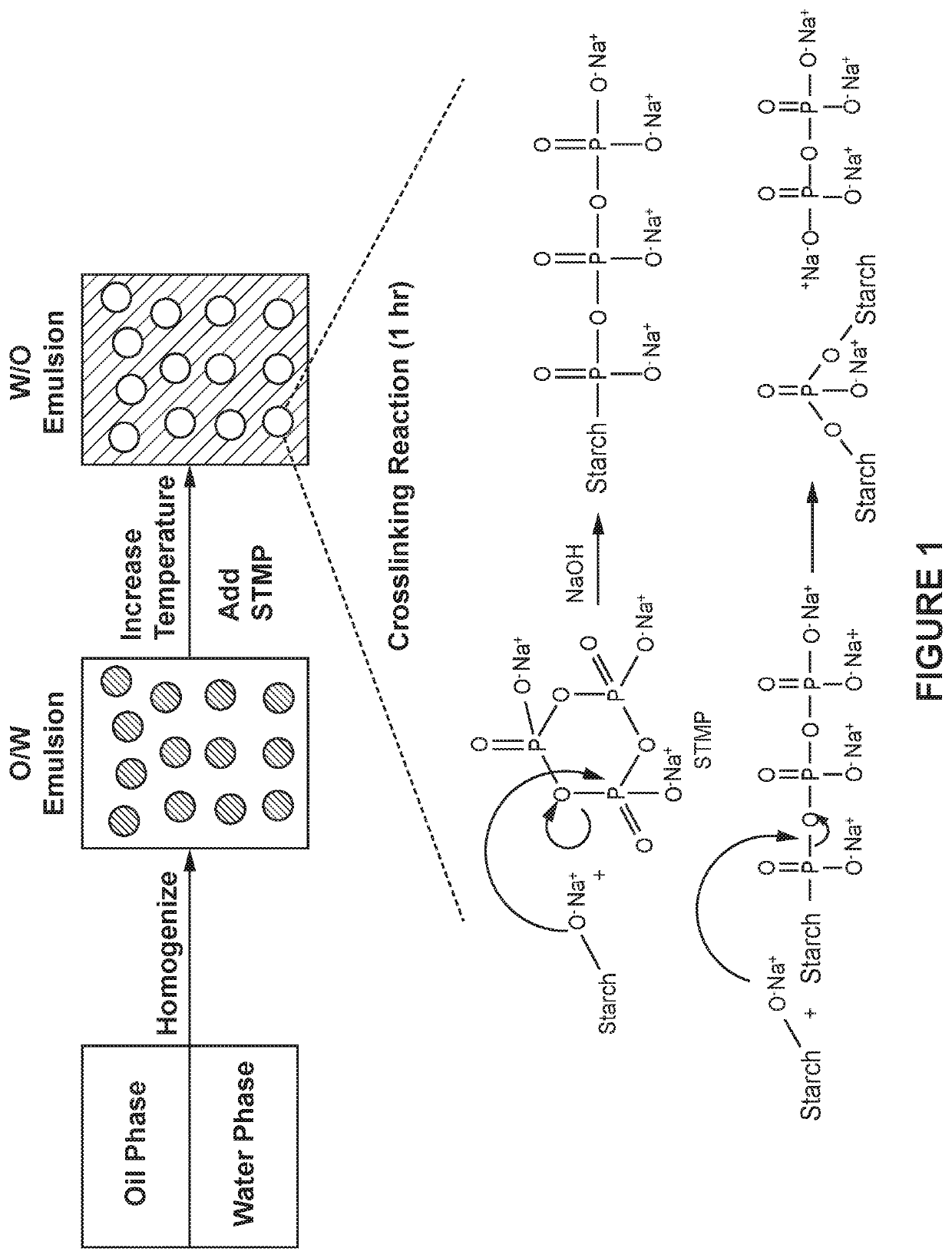Phosphate crosslinked starch nanoparticle and dental treatments
a technology of phosphate crosslinked starch and nanoparticles, which is applied in the field of biopolymer nanoparticles, can solve the problems of pain, infection, irreversible restorative cycle, and poor quality of life, and achieves the effects of improving the quality of li
- Summary
- Abstract
- Description
- Claims
- Application Information
AI Technical Summary
Benefits of technology
Problems solved by technology
Method used
Image
Examples
example 1
Used for the Preparation of Starch Nanoparticles without Cationization in the Emulsion
[0048]In a 1 L plastic beaker 30 g of native waxy corn starch was dispersed into 600 g water along with 16.6 g of NaCl to produce a white suspension of granules. The dispersion was mixed using a Silverson ultra-high shear dissolver agitator at 6500 rpm. 7.5 g of 50% NaOH was added while mixing. The mixer was turned up to 8000 rpm and the temperature of the mixture increased from 22 to 52° C. in ˜20-30 minutes; at 41-42° C. the mixture became transparent; light microscopy of a small droplet placed on a glass slide showed a small fraction of starch granule fragments persisted (with birefringence under cross polarizers). At 52° C. all granule fragments were cooked out in the caustic solution (NaOH serves the dual purpose of cooking out the starch at lower temps, and as catalyst for the subsequent crosslinking reaction with STMP). pH paper showed a pH˜13-14. Microscopy showed the final starch solution ...
example 2
n of Nanoparticles, Optionally with Fluoride and / or Calcium, without Cationization in the Emulsion
[0053]Cooked 1L of a 4.68 wt. % starch solution at 55° C. for 2 hrs at pH 13 containing 0.3-0.6 M NaCl or NaF and leave to cool. Adjust to a pH of 13 obtained by adding NaOH pellets to the water. Alternatively, disperse 60 g or thermo-mechanically processed starch (or other cold water soluble starch) in 400 mL deionized water containing 10 g NaCl or molar equivalent of NaF. Either method produces a water phase
[0054]Disperse 35 g of Tween 85 in 500 g (600 mL) of paraffin oil to produce an oil phase.
[0055]Add 400 g of starch solution or dispersion (water phase) to the oil phase.
[0056]Homogenize the mixture using a Silverson mixer, keeping track of the temperature.
[0057]Once phase inversion occurs, typically when the temperature is about 50° C., add dry STMP powder if using cooked starch or STMP and 0.95 g NaOH in 3 mL water if using thermo-mechanically processed starch.
[0058]Allowed react...
example 3
n of Nanoparticles, Optionally with Fluoride and / or Calcium, with Cationization in the Emulsion
[0066]Combine water, starch, sodium hydroxide, surfactant (Tween 85), and oil (mineral oil or paraffin oil) to mixing vessel. Start mixing with high shear mixer and mix until emulsion is formed ˜10 minutes.
[0067]Add salt (NaCl) and / or sodium fluoride and / or sodium fluorescein, allow to mix until temperature is >60° C.
[0068]To cationize starch, add a mixture of glycidyl trimethyl ammonium chloride (GTAC), DI-water, and 2-propanol and allow to react for about 1 hour (30-90 minutes). Monitor temperature and maintain between 60-75° C. by adjusting high speed mixer mixing rate.
[0069]Add STMP to mixture and allow to react / cross-link for about 1-2 hours (30-150 minutes). Monitor temperature and adjust mixing speed to maintain temperature less than 75° C. but greater than 60° C. Measure batch pH, and ensure still basic (about pH 10).
[0070]If calcium is desired, add calcium chloride (dihydrate), op...
PUM
| Property | Measurement | Unit |
|---|---|---|
| Size | aaaaa | aaaaa |
| Size | aaaaa | aaaaa |
| Size | aaaaa | aaaaa |
Abstract
Description
Claims
Application Information
 Login to View More
Login to View More - R&D
- Intellectual Property
- Life Sciences
- Materials
- Tech Scout
- Unparalleled Data Quality
- Higher Quality Content
- 60% Fewer Hallucinations
Browse by: Latest US Patents, China's latest patents, Technical Efficacy Thesaurus, Application Domain, Technology Topic, Popular Technical Reports.
© 2025 PatSnap. All rights reserved.Legal|Privacy policy|Modern Slavery Act Transparency Statement|Sitemap|About US| Contact US: help@patsnap.com


